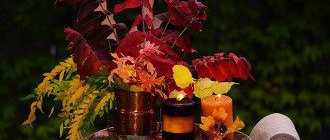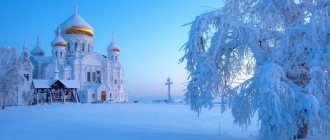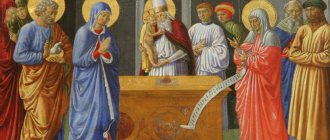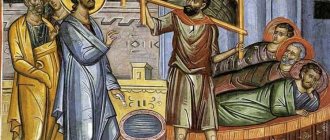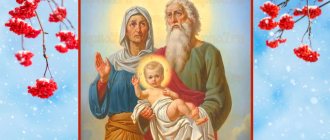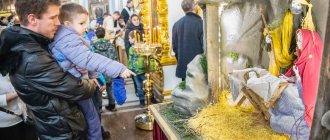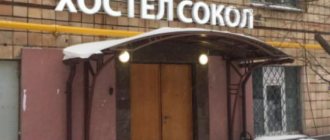Folk signs on October 4
- The weather on this day will remain unchanged for four weeks.
- If the weather is sunny and warm, but the wind blows from the Northeast or North, then the winter will be cold.
- What is the weather like on Matvey - it will be like this for another 4 weeks.
- If on this day it is clear with a sharp northeast wind, then it will be a cold winter.
- High cirrus clouds with curls are moving slowly - the weather will improve.
- A bright orange sun means a strong wind.
- Large circles appeared around the moon or sun, the inner part of which was painted red, and the outer part blue-violet, indicating that the weather would soon worsen.
- Whatever the weather is like on Kondrat and Ignatius, it will remain like this for the whole month.
- If the cold has intensified, then you can say goodbye to good weather.
- If there are no mushrooms, but a lot of nuts, then the winter will be harsh and snowy.
- If it’s cold during the day and gets warmer at night, expect bad weather.
- You definitely need to work a lot, because this is what promises prosperity and a lot of money in the near future.
World Days
• World Animal Day, or World Animal Day, celebrated throughout the world annually on October 4, was established at the International Congress of Nature Supporters, held in 1931 in Florence (Italy), and is intended to draw humanity’s attention to the problems of the rest of the planet’s inhabitants .
• World Smile Day is celebrated annually on the first Friday of October. This wonderful holiday exists thanks to artist Harvey Bell.
Representatives of the insurance company State Mutual Life Assurance Company of America approached him with a request to come up with some bright and memorable symbol - the company’s business card. Harvey didn’t think long, took it and offered customers what now all Internet users without exception call a “smiley” - a smiling yellow face. This happened in 1963.
Died
• Rembrandt Harmens van Rijn (1606-1669) - Dutch artist.
• Vladimir Dal (1801-1872) - doctor, lexicographer, author of the “Explanatory Dictionary of the Living Great Russian Language.”
• Jacques Offenbach (1819-1880) - French composer.
• Olena Pchilka (1849-1930) - Ukrainian writer, editor, mother of Lesya Ukrainka.
• Maria Zankovetskaya (1854-1934) - theater actress, People's Artist of the Ukrainian SSR.
• Max Weber (1881-1961) was an American abstract artist.
Rembrandt Harmens van Rijn. Aristotle looks at a bust of Plato. Photo: Commons.wikimedia.org
Reading the Gospel:
Gospel of Mark, chapter 8, verses 34 - 38, chapter 9 verse 1
Read excerpt
34 And he called the people with his disciples, and said to them, “If anyone wants to come after me, let him deny himself, and take up his cross, and follow me.” 35 For whoever wants to save his life will lose it, but whoever loses his life for My sake and the Gospel will save it. 36 For what does it profit a man if he gains the whole world and loses his own soul? 37 Or what ransom will a man give for his soul? 38 For whoever is ashamed of Me and My words in this adulterous and sinful generation, of him will the Son of Man also be ashamed when He comes in the glory of His Father with the holy angels.
1 And he said to them, “Truly I say to you, there are some standing here who will not taste death until they see the kingdom of God come with power.”
Collapse
Priest Dmitry (Baritsky) comments
Gospel of Matthew, chapter 15, verses 21 - 28
Read excerpt
21 And Jesus departed from there and departed into the countries of Tire and Sidon. 22 And behold, a Canaanite woman came out of those places and cried out to Him: Have mercy on me, O Lord, son of David, my daughter is cruelly raging. 23 But He did not answer her a word. And His disciples came up and asked Him: let her go, because she is screaming after us. 24 And he answered and said, I was sent only to the lost sheep of the house of Israel. 25 And she came up and bowed to Him and said: Lord! help me. 26 He answered and said, “It is not right to take the children’s bread and throw it to the dogs.” 27 She said: Yes, Lord! but the dogs also eat the crumbs that fall from their masters’ table. 28 Then Jesus answered and said to her, O woman! great is your faith; let it be done to you as you wish. And her daughter was healed at that hour.
Collapse
Priest Stefan (Domuschi) comments
Apostolic reading:
The Epistle of the Apostle Paul to the Galatians, chapter 2, verses 16 - 20
Read excerpt
16 However, knowing that a person is not justified by the works of the law, but only by faith in Jesus Christ, we also have believed in Christ Jesus, so that we might be justified by faith in Christ, and not by the works of the law; For by the works of the law no flesh will be justified. 17 If, seeking justification in Christ, we ourselves turned out to be sinners, then is Christ really the minister of sin? No way. 18 For if I build again what I have destroyed, I make myself a transgressor. 19 By the law I died to the law, that I might live to God. I have been crucified with Christ, 20 and it is no longer I who live, but Christ who lives in me. And the life I now live in the flesh, I live by faith in the Son of God, who loved me and gave Himself for me.
Collapse
Priest Dmitry (Baritsky) comments
Features of Orthodox worship
At the end of each liturgy, all believers gathered in the church sing aloud the short and most famous prayer - “Our Father.” We have sorted out the most common misunderstandings about prayer, which Christ taught us in the Gospel. You will find the answers in our material - “Ten Questions about the Main Christian Prayer.”
Our regular “In Brief” column will help you figure out exactly when you can sing in church.
Read the sequence of the Liturgy
New Martyrs and Confessors of Russia
Hieromartyr Alexander Fedoseev (1866 - October 4, 1918)
A graduate of the Perm Theological Seminary served in the Epiphany Church of the Solikamsk district in the factory village of Maykor for 25 years, until his martyrdom. He was shot by Red Army soldiers during mass repressions on October 4, 1918 (according to other sources, the date of death is December 21: he was bayoneted to death on the night before the withdrawal of the Red troops).
Hieromartyr Alexy Stabnikov (March 15, 1868 - October 4, 1918)
At the age of 29, after being ordained as a priest, he was transferred from his native Ryazan province to the Perm region, where he continued to teach the Law of God. According to the memoirs of his wife Natalya Mikhailovna, Father Alexy could not accept Soviet power.
Read the life
Following the appeals of Patriarch Tikhon and Archbishop Andronik, Father Alexy openly condemned the actions of the new government. He typed his sermons on a typewriter and after the proclamation he kept the sheets, so during the first search these sermons were found, after which his arrest followed.
At the time of the arrest there were four children: Tikhon, a participant in the First World War, second lieutenant; Sofia, a graduate of the Perm gymnasium, sons Nikolai and Vsevolod.
He was shot among the hostages “for clearly counter-revolutionary activities” and “in response to an attempt on the life of members of the Extraordinary Commission.”
After the occupation of Perm by the Whites, on May 8, 1919, at the 4th verst along the Siberian Highway from Perm, the bodies of eight people were found shot by the Bolsheviks: seven of them were of clergy and one was secular. Among them the body of Archpriest Alexy Stabnikov was found. The funeral service was held in the Sludskaya Church (Holy Trinity) on May 13, and he was buried in the Bishops' Cemetery near the Holy Transfiguration Cathedral of Perm.
Collapse
Hieromartyr Konstantin Shirokinsky (July 6, 1871 - October 4, 1918)
The father of nine children, priest Konstantin, for 26 years combined serving in the temple with teaching the Law of God. Wherever he lived, he was actively involved in education and missionary work. His last appointment was in 1915 as a vacancy as a priest of the second staff at the Sludsk Holy Trinity Church in Perm. It was there that he was arrested on the night of September 9, 1918 as a “monarchist and counter-revolutionary.” Over the following days, the wife and children sent petitions to the GubChK for release from arrest of “breadwinner and father Konstantin Grigoryevich Shirokinsky for the sake of hungry children and sick mother.”
Read the life
The arrested priests asked in their petition to explain the reason for the arrest and to release them in order to continue serving and implement the decree on the separation of Church and state. The Perm clergy (33 signatures) asked to bail the prisoner: priest Konstantin Shirokinsky, “since his absence puts a heavy burden on his colleagues, who are also obliged to provide full support for the prisoner’s family.”
However, on October 4, 1918, Father Konstantin Shirokinsky was sentenced to capital punishment and executed on the same day. He was buried in Perm at the bishop's cemetery.
Collapse
Hieromartyr John Flerov (August 29, 1870 - 1918)
All his life, Priest John served as rector of the Church of the Archangel Michael in the village of Semyany, Vasilsursky district, Nizhny Novgorod province; after fires, he built a wooden church several times, then a stone one. The organization of construction required serious efforts, since it was carried out only by the parish - local peasants.
Read the life
Already in March 1917, the Soviet government arrested the priest several times: there were informers, but parishioners always stood up for him - once 450 residents of Semyan signed an appeal. The police arrested some peasants for trying to intercede on behalf of the shepherd. The last time priest John was arrested by the Cheka was during the September punitive expedition after the peasant uprising in the summer. In prison they demanded that he renounce his priesthood, but he refused . The priest was sentenced to death.
According to recollections, when he was led to the place of execution, a lot of people gathered - almost everyone in the Vasilsur district knew Father John. But those who came were quickly dispersed. The grave was dug at the edge of the cemetery in front of the condemned man. According to others, they forced me to dig it myself. Among the punishers, half were Semyonsky, armed with rifles and believing in the power of the newfound power. According to legend, before his execution, Hieromartyr John read the prayer of departure over himself . And when he finished, he said:
- Well, now I'm ready. Well, now, go ahead and shoot. Don't shoot at the cross.
First they fired upward, and then at the priest. He fell noisily into the grave. After the death of the priest, he appeared to many in dreams.
A day later, the dean of the district, Archpriest Vasily Uspensky, in his report addressed to His Eminence Lavrenty (Knyazev), Bishop of Balakhninsky, reported: “On September 6 of this year, the death of the priest of the village of Semyany, Father John Flerov, who was under my jurisdiction, followed. The latter died by verdict of the Soviet government. The act for which priest Flerov was convicted is unknown to me. He left behind a wife and no children...” When the dean wrote this letter, he could not even imagine that two months later
His Eminence Vladyka Lavrenty will also be shot.
After the death of Father John, representatives of the local committee of the poor confiscated all valuable property from his mother Serafima Petrovna, but left the house and a small orchard, once planted by her husband. Over the next 12 years, she worked as a prosphora server at the Arkhangelsk Church. On March 25, 1930, a decree was signed for her arrest on charges of being associated with a group of dispossessed kulaks. She did not plead guilty, but according to the verdict of the OGPU, the 55-year-old mother was exiled to the Northern Territory for three years. Her further fate remains unclear.
Born in Nizhny Novgorod in the family of a deacon, the future holy martyr John Claudianovich lived a peaceful and predictable life: after graduating from theological seminary, he served as a teacher, got married, and became a priest. Soon his only child, Evgeniy, : as a 19-year-old volunteer, he went to the front in 1915 and died from wounds a little earlier than his father, in April 1918.
Michael the Archangel Church was closed in the 1930s, but remained intact
ruined before its opening in the 1940s. During the terrible Great Patriotic War, thanks to the courage of believing local women, services were resumed in the temple.
Collapse
Venerable Martyr Mauritius (Poletaev) (September 18, 1880 - October 4, 1937)
Mikhail spent his childhood in Kronstadt at St. Andrew's Cathedral (destroyed in 1932), where his father, Protodeacon Vladimir Poletaev, served under Righteous John of Kronstadt. After the seminary, Mikhail got married, was ordained, served as a priest in the Russian army in Turkminestan, became a widower, the children grew up and lived separately. In 1927, he became a monk at the Moscow Nikitsky Monastery, served in Yuryev-Polsky, and already in 1928 he was arrested on charges of “counter-revolutionary activity” and sentenced to three years of exile in Orel. After serving his exile, he came to Sergiev Posad, where he served as rector of the Kukuevskaya Church until his arrest.
Read the life
On October 21, 1935, he was arrested in a group case of “clergy and churchmen led by Archimandrite Mauritius. Zagorsk 1936,” during the investigation he was kept in Butyrka prison.
On February 8, 1936, by a Special Meeting of the NKVD of the USSR, he was sentenced to three years and the next day he was transferred to the Karaganda camp (Karlag).
In 1937, he was arrested in Karlag on charges of creating a group that “systematically met, held services, and spread counter-revolutionary and religious sentiments among camp inmates aimed at discrediting the Soviet government.” In the case, his words were quoted: “The Lord is merciful, he sees our suffering for the faith, the mockery of believers by people who have sold themselves to the Antichrist,” “... our suffering will come to an end, that the faith of true Christians will triumph in Russia again.”
On September 28, 1937, a troika at the NKVD in the Karaganda region was sentenced to death. According to the stories of Bishop Guriy (Egorov) of Tashkent, who was imprisoned with him, Father Mauritius was severely tortured in the camp and then shot on October 4.
Collapse
Martyr Vasily Kondratiev (March 1, 1887 - October 4, 1937)
Vasily Emelyanovich Kondratyev in 1926 - 1935 was the headman of the church in Zagorsk (Sergiev Posad) and shared the fate of its rector, the Venerable Martyr Mauritius (Poletaev). On October 21, 1935, they were arrested together and imprisoned in Butyrka prison. He pleaded not guilty. He was also sentenced to three years of correctional labor in Karlag and two years later they began a new case, accusing him of providing his “apartment” for worship. Vasily Emelyanovich did not admit guilt, he only confirmed the presence of the icon. Shot on the same day as the Venerable Martyr Mauritius and buried in a common unknown grave.
Hieromartyr Vasily Krymkin (1901 - 1942)
Vasily Ivanovich grew up in a monastery: at the age of eight he entered the Trinity Monastery near Lebedyan, graduated from the monastery school and was a novice until the monastery was closed in 1928. Then he returned to his native village of Protasovo, where he served as a psalm-reader. In 1930 he became a priest and for 7 years before his arrest he served in the Trinity Church in the village of Ostafyevo, Moscow Region. On December 4, 1937, he was arrested and interrogated: “I do not plead guilty to the charges brought against me, because I did not conduct anti-Soviet agitation among the population.” On December 7, 1937, the NKVD troika sentenced Father Vasily to 10 years in prison.
Priest Vasily Krymkin died in a labor camp in the Kuibyshev region on October 4, 1942.
New Martyrs of Nizhny Novgorod
The seven clergymen we talk about below were arrested almost simultaneously and were involved in the same case. They may have known each other, but they were not intimately acquainted. All of them were sentenced to death by the NKVD troika in the Gorky region on September 21, shot on the same day - October 4, 1937 and buried in a common unknown grave at the Bugrovsky cemetery in Gorky (now Nizhny Novgorod).
Hieromartyr Valens Nikolsky (February 2, 1885 - October 4, 1937)
A talented missionary, teacher of the Law of God and choral singing, organizer of a church choir from peasants, he was the son of a deacon in a small village in the Nizhny Novgorod region. For seven years, until 1916, he served as a deacon, completed anti-schism courses, and continued to teach. Having become a priest, for the next 10 years he served in the wooden Ascension Church with a chapel in honor of St. Sergius of Radonezh in the village of Andreikovo, recently built at the expense of parishioners. It was they who stood up for the pastor, signing an appeal in 1918 with a request to release the priest detained following a denunciation. Beginning in 1926, Priest Valens served as rector of the Church of the Epiphany in the village of Trofimov. In 1932, he was convicted of failing to pay an excessive tax, but after his imprisonment he returned to ministry. In 1937 he was arrested again.
Read the life
Denunciations against Father Valens were sent by mail to the chairman of the Trofimovsky village council and the leadership of the Gorky NKVD: “How are you doing with priest Nikolsky, who is campaigning against the collective farm. He quietly lays his webs on citizens. He is a Black Hundred, what did he do in the village. Katunkah, when he was a deacon. We need to expose such a parasite. With communist greetings, sympathizer." “Comrade Commissioner! What kind of almondism is there in the Lyskovsky NKVD with the priest of the village Trofimov Nikolsky, he is campaigning against the collective farm here, but no measures are taken against him.”
During the only interrogation (the day after the arrest), priest Valens denied all charges and did not sign false evidence against the other accused. Having failed to obtain the necessary testimony, the NKVD investigator wrote down: “the accused Nikolsky Valent Ivanovich behaves defiantly during interrogations, insults the investigator and slanders the NKVD.” Based on this, on August 17, 1937, a decision was made to imprison the consecrated man in a punishment cell for a period of fifteen days. But, despite all the bullying and torture, Father Valens did not change his testimony.
Collapse
Hieromartyr Alexander Belyakov (February 23, 1890 - October 4, 1937)
For twenty years, from the moment of his ordination in 1916, he served in the Arkhangelsk Church of the same faith in the village of Sokolovka. But he was called to martyrdom from his native Holy Spiritual Church in Nizhny Novgorod, where his father served as a deacon. It was there that he was appointed rector after the closure of the Archangel Church. The service lasted only a year - until his arrest on August 6, 1937. He was accused of participating in a church-fascist underground organization. Only a month later the only interrogation took place, during which the priest denied all accusations.
Priest Alexander Belyakov was shot on October 4, 1937 and buried in a common grave at an unknown execution site of the Gorky NKVD.
Hieromartyr John Nikolsky (October 8, 1868 - October 4, 1937)
The son of a rural priest in the Nizhny Novgorod province graduated from the seminary and was ordained a priest. In 1933, he was under arrest for three and a half months. In recent years, he served in the Church of the Transfiguration of the Savior in the village of Karpovka on the outskirts of the city of Gorky (Nizhny Novgorod).
On August 6, 1937, he was arrested along with a group of priests and laymen of the city of Gorky and imprisoned in the city prison. He was accused of participating in a “counter-revolutionary fascist organization,” allegedly headed by Metropolitan Feofan (Tulyakov) of Gorky. He did not plead guilty and refused to testify against other people, just like his namesake (not a relative), the holy martyr Valens, who suffered on the same days and was sentenced to death.
Hieromartyr John Lazarev (January 12, 1876 - October 4, 1937)
After his ordination, he served in the village of Baranovo, then in the large artisanal-industrial village of Pavlovo on the Oka River. On his initiative, a parochial school was built in the village of Kryukovo, where he was the head and teacher for more than 10 years. He taught the Law of God at the Pavlovsk Higher Primary School for boys, a two-year zemstvo school and at a private gymnasium.
On July 19, 1913, he was appointed rector of the Nizhny Novgorod Church of the Assumption of the Mother of God, on Ilyinskaya Mountain. In the city, Father John continued to teach as long as possible.
Read the life
Facts from childhood and family life
After the death of his mother, John, along with his brother and sister, was raised by his grandfather and began studying at a rural school founded by his grandfather, an ascetic of public education. Having learned to read early, the boy enjoyed studying his grandfather’s large library, especially the lives of saints.
Then his aunt took the five-year-old boy to Nizhny Novgorod, where she settled with him in the apartment of his older brother, candidate of theology, teacher of the Nizhny Novgorod Theological Seminary, priest Alexei Alexandrovich Porfiryev.
On Sundays and holidays, Vanya Lazarev served his uncle in the St. Nicholas Church, and then in the ancient Kremlin temple in honor of the Archangel Michael. When Serafima Alexandrovna married the official Pyotr Afanasyevich Nikolsky, Vanya and her brother and sister began to be brought up in a new family. Subsequently, Peter Nikolsky, being a deeply religious and pious man, coming from a priestly family, left public service, accepted the rank of deacon, and then priest, and left with his family to the village of Sopchino, Semenovsky district, which became his first parish. It was in this village that Ioann Lazarev spent his teenage years. Subsequently, throughout his life, Father John revered Priest Peter Nikolsky and his mother Serafima Alexandrovna as true parents, and called their own children siblings.
A year after graduating from theological seminary, he married the daughter of a priest from the village of Gorodets, a graduate of the diocesan women’s school, Anna Efimovna, with whom he lived for less than 20 years. In 1915 he was widowed. The only daughter Elizaveta managed to receive her primary education at a private Nizhny Novgorod girls’ gymnasium. Subsequently, she will try to enter a medical institute, but she will not be accepted there, as the daughter of a famous Nizhny Novgorod priest. Elizaveta Lazareva, despite her father’s objections, married the dramatic actor Evgeny Pisarev early. This marriage broke up, and Father John, who loved his grandson very much, helped in every possible way in raising her only son Gleb.
In 1928, he was first arrested on charges of anti-Soviet activity and was in Gorky prison for a month. Due to the lack of proof of the accusation and in connection with the petition of the parishioners, the priest was released. In the 1930s, he opposed the campaign to close the Assumption Church , together with the parish council, they wrote a letter to the All-Russian Central Executive Committee with a request to leave it to the believers. But a year later the situation repeated itself and it was no longer possible to defend the temple - on January 20, 1934, the church was closed.
In recent years, Father John served in the Nizhny Novgorod Ascension and then St. John the Baptist Church. His health was very weak, and he could no longer perform divine services constantly. Father John served only on Sundays and major holidays.
On the night of August 6, 1937, he was arrested at his dacha and imprisoned in Gorky prison. A search was carried out in the city apartment of Father John: money, the Gospel and liturgical books, as well as more than twenty personal photographs were confiscated. During the investigation, Father John was charged with being an active participant in the Gorky branch of the fascist church sabotage, terrorist and espionage organization headed by Gorky Metropolitan Feofan (Tulyakov). In addition, Father John was accused of allegedly recruiting new participants into this counter-revolutionary organization and collecting espionage information about the mood of various segments of the city's population.
At the only interrogation, which took place on August 9, 1937, Father John did not admit guilt.
Collapse
Hieromartyr Andrei Benediktov (October 29, 1885 - October 4, 1937)
From the memoirs of N. Anatolyevich Benediktov, Doctor of Philosophy, grandson of the Hieromartyr Andrei: “Deprived of civil rights, Fr. Andrei earned food for his large family through peasant labor. He was one of the founders of the agricultural cooperative. ..He was not only nearsighted by nature, but he aggravated the weakness of his eyes by reading. My grandmother said that her husband always amazed her with his depth of knowledge in various fields. From him, the notes of the Liturgy, the Bible, the complete works of St. John Chrysostom and other books came down to his descendants. The notes in the margins of the latter characterize Father Andrei as a very educated person.”
In the family of priest Andrey, children were born and raised: Alexey, Anatoly, Boris, Nikolay, German and Evgeny. The sons went to the front and became prominent scientists in the fields of physics, mathematics, linguistics, and history.
Read the life
He got married after graduating from the seminary in 1908, was soon ordained, and from 1909 to 1925 he served in the Kazan Church in the village of Sunevo, while heading the parochial school. The construction of the new stone church was completed by 1915.
The first arrest occurred in 1925 for refusing to marry a Komsomol member without repentance. In 1932, on charges of “anti-Soviet activity against collective farms,” he was under investigation in an Arzamas prison for more than seven months. He was also accused of preparing an explosion. And after his liberation, the authorities forbade serving in the church of St. John of Damascus in Sergach, to whom he gave 4 years of his life. Over the past 5 years, he served in three Gorky churches - he had to move because the authorities were constantly closing the churches.
On August 7, 1937, he was arrested along with other priests of the city. During the investigation, he denied any participation in counter-revolutionary organizations and refused to name his personal connections. Father was very short-sighted and broke his glasses (which he reported to his relatives in the only note from prison), and because he was unable to read the interrogation report, he refused to sign it. More about. Andrey was not interrogated.
Collapse
Hieromartyr Peter Sakharovsky (August 20, 1876 - October 4, 1937)
In 1937, during the search and arrest of Archpriest Pyotr Sakharovsky, his personal correspondence and various manuscripts, including poetry, were confiscated. One of the poems, a dedication to a book of spiritual content, was regarded as anti-Soviet propaganda:
"Let this book of Salvation
Gives you comfort
during the years of struggle and labor."
To this accusation, the priest replied that this verse calls on believers to fight passions.
Read the life
A sermon found during the search, delivered back in 1930 in the Trinity Church on the holiday in honor of the martyr Paraskeva Pyatnitsa, was also regarded by the investigation as a call to fight against Soviet power, to which Father Peter answered the investigator:
“With this sermon, I aimed to draw the attention of believers to the Great Martyr Paraskeva, who suffered torment and bullying, but did not lose courage and patience in the struggle for the faith of Christ, and called on believers to be courageous and patient in the fight against all kinds of adversity and to turn to the Hieromartyr Paraskeva for help.” .
Ten years until 1900 he worked as a clerk at the office of the Nizhny Novgorod bishop in the Ascension Pechersky Monastery, then served as a deacon and taught. And only on December 22, 1918, was he ordained a priest, when persecution had already begun and he was repeatedly subjected to arrests and searches. During the latter, in August 1937, the following were confiscated from him: a gold chain from a watch, silver vestments (frames) from icons, a cross with a chain, a gold cross with a crucifix, and vessels for communion. Father Peter was presented with a variety of accusations, but he did not agree with any of them and did not plead guilty.
Collapse
Hieromartyr John Bystrov (1888 - 1938)
Seminarian John with his sisters
John Alexandrovich had the gift of teaching and was famous among teachers. But he decided to serve the Church and became a priest shortly before the 1917 revolution. They tried to persuade him to leave ministry and return to teaching, and they promised to make him a school director. However, Father John refused to remove the cross.
On September 10, 1937, he was arrested on charges of “systematically carrying out counter-revolutionary and terrorist agitation among the surrounding masses” and imprisoned in the city of Bogorodsk. He pleaded not guilty.
Historical events
1582 - Pope Gregory XIII introduced the Gregorian calendar, the next day was announced as October 15.
1675 - Dutch physicist Christiaan Huygens patented a pocket watch.
1800 - the first blast furnace was launched in Lugansk.
1911 - The first escalator was put into operation in London.
1957 - The first artificial Earth satellite was launched in the USSR.
1959 - The Luna 3 spacecraft was launched, photographing the far side of the Moon for the first time.
1995 - Television broadcast of the cult series “Neon Genesis Evangelion” began in Japan.
Francesco Solimena. "Allegory of Kingship". Photo: Wikipedia
Finding of the relics of St. Demetrius of Rostov (1752)
Icon of St.
Demetrius of Rostov with a scene of veneration of his relics. Deut. floor. XVIII century GMZRK 43 years after the burial of St. Demetrius, on September 21, 1732, the fallen platform in the Conception Cathedral of the monastery was dismantled. The relics and clothes of the saint were found incorrupt, although the coffin had rotted. Over the next 5 years before canonization, more than 300 cases of help and healing from serious illnesses through prayers to the saint were collected and certified under oath. The decree on the canonization of St. Demetrius was the first in the Synodal period and for almost 200 years remained the only one. In the 6 years after canonization, while records of cases of help were being kept, another 203 cases of miraculous healings were recorded.
Today the relics of the Saint are found in the city of Rostov the Great, in the Spaso-Yakovlevsky Dimitrievsky Monastery.
Spaso-Yakovlevsky Dimitriev Monastery, Rostov, Photo: Roman Romanov
Listen to the short life of St. Demetrius on radio “Vera”
Born
• Al-Biruni (973-1048) - medieval Persian scientist, encyclopedist and thinker.
• Francesco Solimena (1657-1747) - Italian artist of the late Baroque era, one of the largest representatives of the Neapolitan school of painting.
• Jean-François Millet (1814-1875) - French artist, one of the founders of the Barbizon school.
• Louis Henri Boussenard (1847-1910) - French writer (“Captain Rip-off”).
• Anne Rice (b. 1938) - American writer (“Interview with the Vampire”).
Jean Millet. "Death and the Woodcutter." Photo: Wikipedia
